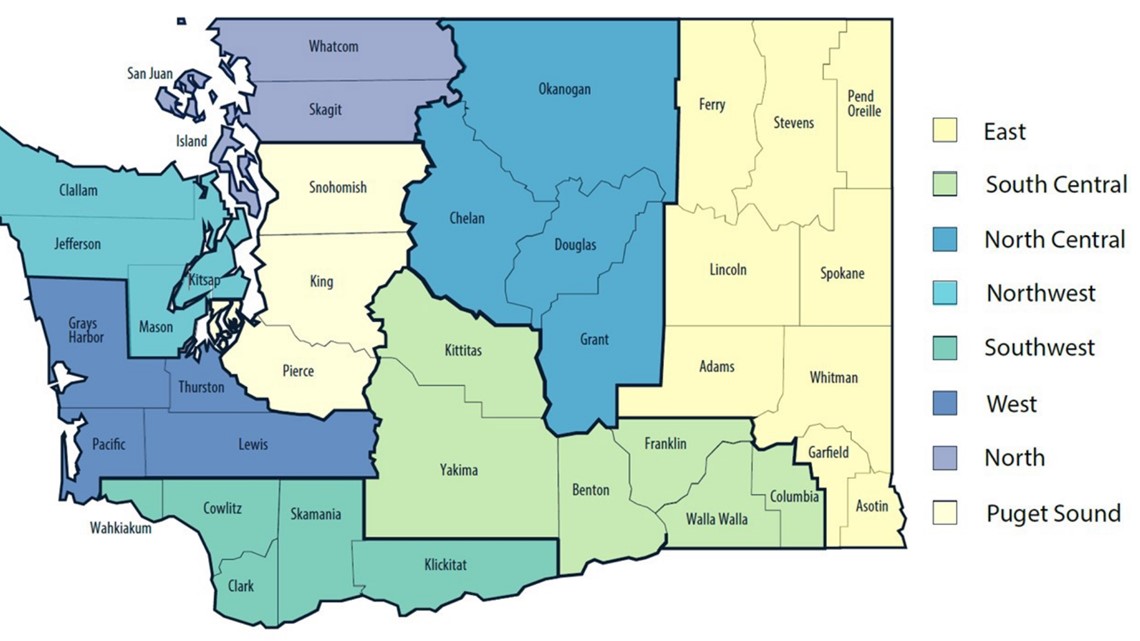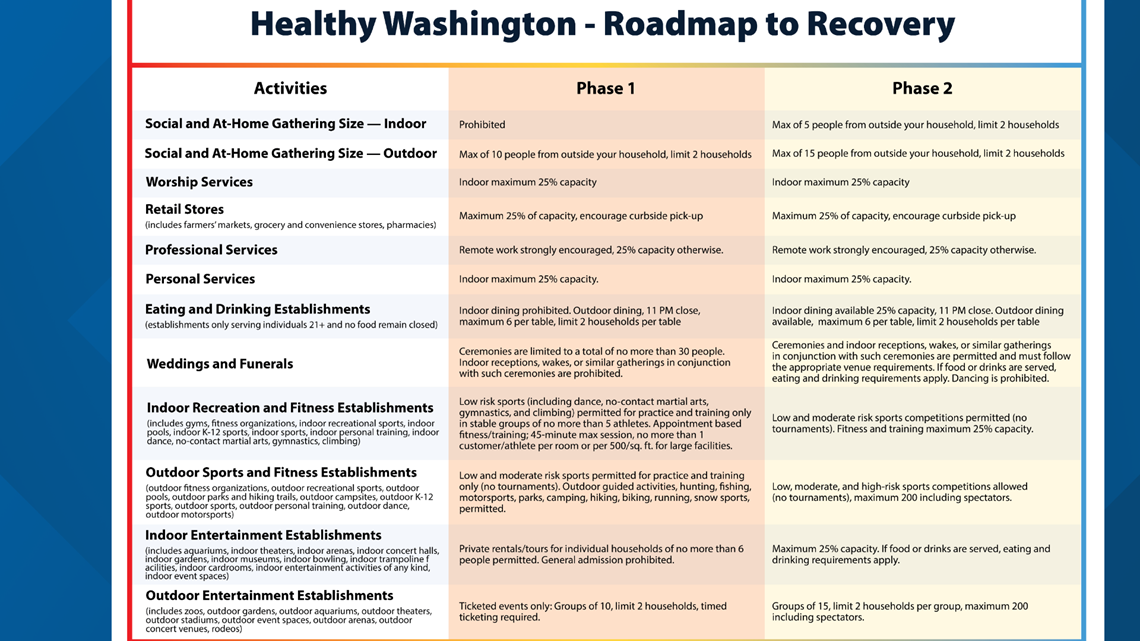SPOKANE, Wash. — Many Spokane and Eastern Washington residents are anxiously awaiting the reopening of businesses such as restaurants and gyms nearly two months after Gov. Jay Inslee implemented his latest round of COVID-19 restrictions.
Inslee recently announced a new reopening plan called "Healthy Washington," which will allow regions to reopen a bit more when they meet four metric requirements around COVID-19 case data and hospitalizations.
Every region, including Eastern Washington, is starting in Phase 1 of the new reopening plan on Monday, Jan. 11.
To move forward from Phase 1 to Phase 2, regions must meet all four of these metrics:
- 10% decreasing trend in two-week rate of COVID-19 cases per 100,000
- 10% decreasing trend in two-week rate new COVID-19 hospital admission rates per 100,000 people
- Total ICU occupancy for COVID-19 and non-COVID-19 patients of less than 90%
- COVID-19 test positivity rate of less than 10%
Regions must meet at least three out of the four metrics to remain in Phase 2 of reopening, according to information shared by Inslee's office. The state will automatically move regions that fail to meet two or more of the metrics back to Phase 1.
As of Friday, Jan. 8, Eastern Washington had only met two of the four requirements. The region satisfied the case rate decrease and ICU capacity marks, but failed when it came to decreasing hospitalizations and positivity rates.
The metrics for each region will be updated on the Washington State Department of Health's Risk Assessment Dashboard every Friday, according to Inslee's office. DOH will move regions into new phases, whether that's forward or backward, the following Monday based on their metrics.
The first round of metrics for regions will be effective Jan. 11.
Here's a breakdown of what Phases 1 and 2 mean for Washington state and where the East region stands as far as metrics.


What's allowed during Phase 1?
Phase 1, for the most part, aligns with current COVID-19 restrictions, with some exceptions. Indoor fitness and outdoor entertainment were previously banned but will now be allowed with restrictions.
Live entertainment is no longer banned but it must follow guidelines for its venue.
Here's what's allowed during Phase 1, which begins for all regions on Monday, Jan. 11:
- Indoor social gatherings are still banned in Phase 1, while outdoor gatherings with a maximum of 10 people from outside of a person’s household are allowed.
- Retail, worship services, personal services, and professional services are limited to 25% capacity.
- Wedding and funeral ceremonies are limited to a total of no more than 30 people. Indoor receptions, wakes or similar gatherings are prohibited.
- Indoor dining remains prohibited in Phase 1. Outdoor dining is allowed with a maximum of six people from two households per table until 11 p.m.
- Low-risk sports, including dance, no contact-martial arts, gymnastics and climbing, are allowed for practice and training only in groups of no more than five.
- Appointment-based fitness and training are allowed with a maximum of 45 minutes per session, and no more than one customer or athlete per room or 500-square-feet for larger facilities.
- Low and moderate risk sports are allowed for practice and training only but tournaments are not permitted. Outdoor guided activities are also allowed.
- General admission to indoor entertainment establishments, including aquariums, theaters, arenas, concert halls, museums and bowling, is prohibited. Private rentals and tours for individual households of no more than six people are allowed.
- Outdoor entertainment venues, including zoos, outdoor theaters and concert venues and rodeos, can reopen. Operation must be by ticketed event only groups of 10 people maximum with a limit of two households. Timed ticketing is required, as well as facial coverings and physical distancing.
What's allowed in Phase 2?
These are the major changes to what's allowed in Phase 2:
- A maximum of five people from outside of a person’s household can gathering indoors.
- A maximum of 15 people from outside of a person’s household can gather outdoors.
- Indoor dining is available at 25% capacity until 11 p.m. Outdoor dining remains available with the same requirements.
- Indoor fitness must also follow the 25% capacity limit.
- Moderate risk indoor sports and all sports outdoors gain flexibility to have league games and competitions.
- Outdoor entertainment venues may host groups of up to 15 with the two-household limit and an overall 75-person maximum.
- Wedding and funeral ceremonies and indoor receptions may take place following the appropriate venue requirements.


Is Eastern Washington meeting metrics?
The state Department of Health released a report on Friday, Jan. 8 showing where each region, including Eastern Washington, is at in terms of meeting the metrics.
Spokane County is part of the East region, along with Ferry, Stevens, Pend Oreille, Lincoln, Adams, Whitman, Garfield and Asotin counties.
Here's what we know as of Friday, Jan. 8.
Case and hospitalization metrics
The coronavirus case rate per 100,000 people in the East region has decreased by 28% over a two-week period, according to the DOH report. The state looked at the time period of Nov. 29, 2020 to Dec. 1 compared to Dec. 13-26.
Eastern Washington has satisfied this metric, as the case rate per 100,000 people must decrease by at least 10% over two weeks.
New hospital admissions, though, increased in Eastern Washington by 22% from Dec. 6-19 compared to Dec. 20 through Jan. 2, the DOH said in its report.
Hospital admissions must decrease by 10% per 100,000 people over a two-week period in order for regions to move forward.
ICU capacity
Eastern Washington satisfied the metric for ICU capacity, with 69% of staffed beds occupied from Dec. 27, 2020 to Jan. 2, 2021, according to the DOH.
Total ICU occupancy for COVID-19 and non-COVID-19 patients must be less than 90% for each region.
Test positivity
Test positivity is also hindering Eastern Washington's progress n reopening. The region is well above the metric of less than 10% that is required for moving into Phase 2.
Test positivity in the East region was sitting at 17% from Dec. 13-19, 2020, according to the DOH.

